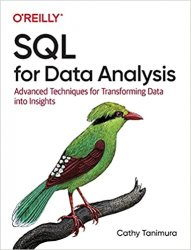SQL for Data Analysis: Advanced Techniques for Transforming Data into Insights (Final)
- Добавил: literator
- Дата: 10-09-2021, 03:32
- Комментариев: 0
 Название: SQL for Data Analysis: Advanced Techniques for Transforming Data into Insights (Final)
Название: SQL for Data Analysis: Advanced Techniques for Transforming Data into Insights (Final)Автор: Cathy Tanimura
Издательство: O’Reilly Media, Inc.
Год: 2021
Страниц: 350
Язык: английский
Формат: epub
Размер: 10.28 MB
With the explosion of computing power, thanks to analytic databases and cloud data warehouses, SQL has become an even more robust and flexible tool for the savvy analyst or data scientist. This practical book reveals hidden ways to get the most out of your SQL workflow. You'll learn how to use both common and exotic SQL functions such as joins, window functions, subqueries, and regular expressions in new, innovative waysA Ac??as well as how to combine SQL techniques to accomplish your goals faster, with more understandable code. If you work with SQL databases, this is a must-have reference. SQL for Data Analysis covers useful applications such as: Cohort analysis Text analysis Anomaly detection Time series analysis Experiment analysis Creating complex datasets for further exploration in statistical and visualization tools And more.
If you’re reading this book, you’re probably interested in data analysis and in using SQL to accomplish it. You may be experienced with data analysis but new to SQL, or perhaps you’re experienced with SQL but new to data analysis. Or you may be new to both topics entirely. Whatever your starting point, this chapter lays the groundwork for the topics covered in the rest of the book and makes sure we have a common vocabulary. I’ll start with a discussion of what data analysis is and then move on to a discussion of SQL: what it is, why it’s so popular, how it compares to other tools, and how it fits into data analysis. Then, since modern data analysis is so intertwined with the technologies that have enabled it, I’ll conclude with a discussion of different types of databases that you may encounter in your work, why they’re used, and what all of that means for the SQL you write.
What Is Data Analysis?
Collecting and storing data for analysis is a very human activity. Systems to track stores of grain, taxes, and the population go back thousands of years, and the roots of statistics date back hundreds of years. Related disciplines, including statistical process control, operations research, and cybernetics, exploded in the 20th century. Many different names are used to describe the discipline of data analysis, such as business intelligence (BI), analytics, data science, and decision science, and practitioners have a range of job titles. Data analysis is also done by marketers, product managers, business analysts, and a variety of other people. In this book, I’ll use the terms data analyst and data scientist interchangeably to mean the person working with SQL to understand data. I will refer to the software used to build reports and dashboards as BI tools.
Data analysis in the contemporary sense was enabled by, and is intertwined with, the history of computing. Trends in both research and commercialization have shaped it, and the story includes a who’s who of researchers and major companies, which we’ll talk about in the section on SQL. Data analysis blends the power of computing with techniques from traditional statistics. Data analysis is part data discovery, part data interpretation, and part data communication. Very often the purpose of data analysis is to improve decision making, by humans and increasingly by machines through automation.
Скачать SQL for Data Analysis: Advanced Techniques for Transforming Data into Insights (Final)
[related-news] [/related-news]
Внимание
Уважаемый посетитель, Вы зашли на сайт как незарегистрированный пользователь.
Мы рекомендуем Вам зарегистрироваться либо войти на сайт под своим именем.
Уважаемый посетитель, Вы зашли на сайт как незарегистрированный пользователь.
Мы рекомендуем Вам зарегистрироваться либо войти на сайт под своим именем.
